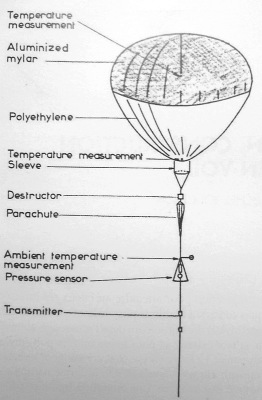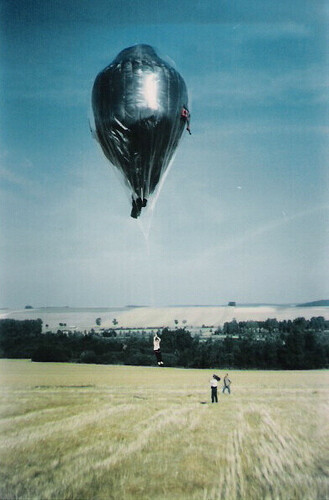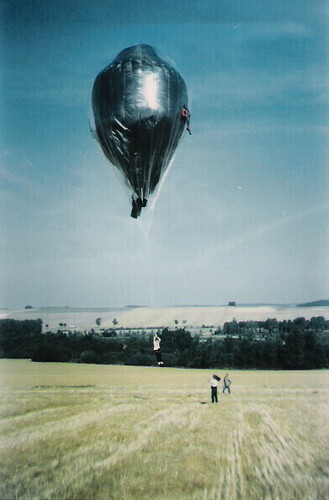How about a solar-heated humidity hot-dog spinning above a powered-parachute fan?
You would of course have to wait for the sun to come up, no clouds, then you could take off, burning some gas to accomplish rotation as well as powering the propeller.
And then make all other forms of aviation illegal, to “save the planet”…
Powered parachutes are real. I know people who do it. This idea??? Is this just a silly conversation?
I don’t think so. The whole idea is dumb. But if you want to make a balloon I think hydrogen is the best option. Helium is not an option and using humid air or steam or hot air requires you to use infinite material and development time and constant energy input for minimal lift and questionable performance. You’d also need to increase pressure to above ambient to resist wind loading and bending moments, reducing your already limited lifting capacity.
I bet hydrogen is better than that. You can produce the hydrogen sustainably, try to reduce leakage and leaks, and monitor the hydrogen to oxygen ratio. The earlier discussion on hydrogen had people saying air would go in through the fabric, I have seen no evidence of that. Maybe you could have constant sparks in the balloon to controllably get rid of the oxygen that did manage to get in.
I don’t know about aerogel. Is that not quite brittle? You’d want something that is not brittle, like this for example:
English: HeiDAS_UH_en.pdf (808.8 KB)
German: HeiDAS_DGLRKongress2005.pdf (988.6 KB)
Dead link: http://aeroix.de/fileadmin/user_upload/aeroix/redakteure/Dokumente_HeiDAS/2007AIAAHeiDASUH.pdf
Related:
I seem to be in agreement with some more «bystanders» on this one that this challenge is quite large. Again I state that before a set of concrete design choices have been made, it is difficult to comment more exactly.
That being said, I had a look at the heated balloon thread, very briefly so Im probably missing a lot, but compared to a hot air ballon it seems the magnus cylinder would be much more lightweight than a hot air balloon with a few people weight woth in payload. Also the volumes considered here are quite a bit larger than a hot air ballon only maybe 10-20 m size [diameter]. And for the magnus AWE we were talking 1 km length.
This probably means that positive scaling with scale in volume vs skin weight is achieved. So maybe the temperature in the magnus cylinder doesnt have to be very high.
I am assuming that any motors are grounded. Also I am assuming that a hot air ballon could transfer torque, which is probably an assumtion giving very optimistic mass estimates though
“Aerogel”, “collect the runoff”, “if you’re going to go for solar heating of the balloon, which would contribute to global warming”, “You also shouldn’t go for a solar balloon, as that would have a high emissivity.”… (the three last from @Windy_Skies)
To have such ideas, you really have to have no idea what a solar balloon is, and of course never to have built one.
I built two kinds: with a simple envelope, and with a double envelope.
Here is an example with a simple envelope (read the text):

Here is an example with a double envelope:
“Aerogel” is expensive and brittle. One obtains the same result of isolation by implement a transparent envelope, with an air layer between the two envelopes.
“collect the runoff”: make it complicated when you don’t know how to make it simple.
“if you’re going to go for solar heating of the balloon, which would contribute to global warming” : a not supported statement. If we have to say something about this, we could say the opposite, i.e. that direct insolation does not reach the ground.
“You also shouldn’t go for a solar balloon, as that would have a high emissivity.” : Solar balloon - Wikipedia : " A black body absorbs all the radiation that hits it. Real world objects are gray objects, with their absorption being equal to their emissivity. Black plastic might have an emissivity of around 0.95, meaning 95 percent of all radiation that hits it will be absorbed, and the remaining 5 percent reflected."
Incompetence is less forgiven when mixed with arrogance:
One last nonsense:
Should I answer that with only one belt the balance is almost impossible to find?
Incidentally, I experimented with a single belt. I don’t care about your incompetent and pretentious verbiage.
To be honest I think the belts should improve scalability, but not to the point to achieve viability. One of the reasons, unrelated to such a transmission, is that it does not seem possible to reach a high spin ratio (with an inflatable balloon) because of the power consumption which increases according to the cube of the tangential speed of the cylinder, and which is already initially high enough on the balloon that was tested. We therefore arrive at a power per m² comparable to that of a flexible crosswind kite (see the references in the preprint), knowing that for the cylinder the measurement base is the intercepted wind area, in other words the length multiplied by the diameter.
Hi Doug,
Indeed I have rarely read so much bullshit in a row. Even your comments look awesome by comparison.
Check yourself before you wreck yourself. It’s almost always better to respond later when you’ve had time to properly read and digest something.
Thanks for the primer on solar balloons. I didn’t follow your links as I am already familiar with the concept.
The aerogel suggestion wasn’t mine, but apparently that can now be incorporated into clothing and the like so perhaps there are now versions that aren’t brittle.
I say the simple solution either wouldn’t work (insolation too low) or be irrelevant (insolation high enough for solar panels to be a better option). Or you’d need to find a niche where it could make sense.
I make the assumption that a balloon at 300 meters altitude has the same effect on global warming as one at 0 meters elevation.
Yes. Your quotation supports my statements as well. You want to limit heat-loss through radiation as I say in the comment, which you do by using low emissivity materials like aluminium foil or white fabrics. You want to limit heat loss through other means as well of course, which would be another point against solar balloons, as added layers or insulation would prevent the solar radiation from penetrating into the balloon.
…but I don’t frankly have such a problem with the solar balloon part of the concept, I’m sure it will be able to collect enough heat on any location on earth and be well-insulated enough just from the small temperature differences inside and between inside and outside and consequently limited convection, if it is permanently above the clouds, to stay permanently airborne if the radius is high enough. It’s just the amount of plastic needed that would be grotesque, so the need for a Life-cycle assessment - Wikipedia and comparing that to the alternatives. And I haven’t seen attempts at answering questions about fabric strength and thickness needed.
No, the question wasn’t about balance, though that wasn’t very clear. It was about the pressure needed to keep the belt from deforming the balloon and the wind from deforming the balloon and the ends of the balloon, and that at the scale you are proposing and the hoop stress and all that.
I would think carbon fiber composite rings with lips at the edge to hold the belt would form pulleys (sheaves) to handle that stress without undue weight. I would not recommend just belts on fabric - they would migrate to whatever position they wanted and fall off the ends of the balloon.
Nothing is too ridiculous to catch the attention of the true-believers… ![]()
It’s a possibility. Could someone tell what I’m suggesting, and why?
I realize that, for several days, only one person has clicked on DOI, and 3 people on the other link, both links leading to the same publication.
Maybe your contributions could improve if you read the preprint.
And also try to master the related topics better. So, as I already wrote, the following sentences do not make sense: “You also shouldn’t go for a solar balloon, as that would have a high emissivity.” . “You instead want as low an emissivity as possible, to limit heat-loss through radiation.”
My answer: high emissivity is wanted for solar balloons. It is the reason why we use black plastic which “might have an emissivity of around 0.95.” as noted in my quote. If we want limit heat-loss,
a transparent envelope is added and allows an insulating layer of air between the two envelopes. Aerogel is not realistic and not advantageous compared to air layer, and is very expensive and brittle.
“collect the runoff”: no, start with something simple and basic.
“if you’re going to go for solar heating of the balloon, which would contribute to global warming” : a not supported statement. If we have to say something about this, we could say the opposite, i.e. that direct insolation does not reach the ground.
Learn how to build solar balloons with one then two envelopes to begin with.
You’re now polluting your own topic by just copying a previous reply where you misread and failed to understand my comment, but fine:
You are misreading the sentence. I say you shouldn’t go for a solar balloon, as that solar balloon would have a high emissitivity. You instead want as low an emissivity as possible, to limit heat loss through radiation.
I say that with the idea that if you want a balloon that is always airborne through buoyancy, a somewhat insulated heated humid air balloon would be better because it would achieve continuous buoyancy below the clouds at a smaller radius than a solar balloon would, given the needed higher strength envelope material for this magnus idea, and a smaller radius is better. Also given the assumption that this would need to operate in january in cloudy Svalbard.
If it only needed to operate a few hours during the day in Egypt, things change. But then I say you’re better off using solar panels.
If you don’t need a balloon that is always airborne through buoyancy, and instead rely on lift from the wind, you could start experimenting sooner, as long as you have found a renewable fabric material you would use for the envelope.
I did scan your document, I saw no discussion on the variables you should use to determine the needed strength of the envelope, like needed pressure or bending stiffness to deal with wind loading and so on, so I lost interest. Also hence my first comment in this topic, which you have ignored as of yet. We have different interests. I am mostly interested in the practicality of the thing and if it can be built, and the environmental impact. I am not so interested in your calculations on lift, so I skipped that. But on that, you seem to blindly extrapolate the results from a 2.5 meter chord wing to a 200 meter chord wing, without even saying why you could possibly do that, which is not good.
Aerogel seems to come in many forms, also flexible ones. I would not dismiss aerogel composite with a black coating on the inside at this point, as a possible construction for a heated magnus blimp. Eg transparent strong layer - aerogel layer - black coating layer. This could have benefits compared to inner/outer layers with an airgap.
http://www.aerogel.org/?p=1058
Anyways, we could assume that this is not the biggest issue here. And of course these are all layman, shoot from the hip, comments, probably many of them ridiculous to an expert. But that can still be a starting point for discussions
In its basic form a solar balloon works like a greenhouse:
A simple black envelope is efficient because it is a “black body” with a high absorption percentage of the solar radiation, leading to a high emissivity, which is an advantage for heating. But it re-emits outside as well as inside, leading to loss.
The buoyancy has been measured, being about 90 grams/m³ for small balloons, and 80 grams/m³ for larger ones, in free flight, far less in tethered flight due to higher loss of heat by convection.

A double envelope has an external transparent envelope with properties sometimes close to those of glass, keeping almost all infrared from the re-emissions of the black envelope.I measured its buoyancy as about 1.3 times that of a simple black envelope. The thin air layer between the two envelopes is a little like an insulation.
For a Magnus balloon, buoyancy can be high, even too high the day, and low or zero the night. That said, the larger the volume, the longer the heat is retained.
In reeling mode, the buoyancy must be able to be compensated by the negative aerodynamic thrust to allow the balloon to descend during the reel-in phase.
An observation: while rotating the Magnus balloon keeps the feature of buoyancy because it would be symmetrical as for these solar balloons.
Another observation: the centrifugal force leads to the effect of propelling colder air against the walls, isolating the warmer air inside, but also strongly cooling the same wall by convection if the balloon is a single envelope, and to a lesser extent for a double envelope.
Now another mean of buoyancy is described on
and on

The so called Infrared Montgolfier (MIR) is a balloon developed by the Service d’Aéronomie of the CNRS and CNES in 1977 in an attempt to meet the needs of long-duration flights. The MIR is a hot air balloon “open at the bottom” made of 2 different materials: a top part of aluminized Mylar 12 µm thick making a cavity for absorbing ascendants infrared and block any re-emission toward the sky and the bottom part made of linear polyethylene 15µm thick, an infrared transparent material and tough at cold (-80°C). It only uses helium to gain altitude at takeoff. Their reflective cover provides lift heating the air inside the envelope by the sun during the day or by the infrared radiation coming from the earth during the night. During the day, the MIR flies at an altitude of about 28 km to 32 km while at night it floats between 18 and 22 km depending on the infrared flux radiating from the overflown area and the temperature of the air parcel. It could carry a scientific payload of about 50 kg.
An advantage for our balloon would be a permanent (but not quite equal) buoyancy, likely not too high (300 W/m² as noted on the pdf in the first page) because the direct radiation of the sun is not or only slightly absorbed: only the infrared rising from the earth are absorbed. That said it is better than nothing BUT this is not suitable for our Magnus balloon because its rotation leads to a cyclical reversal of the polyethylene part and the aluminized polyester part.
Another point: if we read (has anyone done it?) the preprint we see that the belts run around respective drop stitched double disks which are tracks for said belts. Generally drop stitched technology make it possible to build structures with relatively high pressure like kayaks or paddles. I wonder if a sewn crown is enough or if a complete disc is necessary as for the valves at the ends.
Stil another point: at equal expected power, the amount of waterproof ripstop (in m²) would be comparable to that of flexible crosswind kites at equal power range, but multiplied by 3.14 (the area of reference of a cylinder being its length multiplied by its diameter; so still multiplying by 3.14 is needed). That said the strength of a Magnus balloon (above all if it is harmoniously shared between disks-belts-tethers) flying vertically slowly can perhaps be lesser. Lifetime remains to experiment. For both recyclable materials would be welcome.
The Reynolds number would be higher, on which basis a bigger one should work better.
This is the kind of thinking typical of dreamers and newbies, not comprehending simple aspects like wear-and-tear on fabric components that rub together. It all depends if you want something to work for a few minutes or hours, or years. I was skeptical when I saw the term “drop-stitched” used as a magic word that would somehow overcome all the problems of a belt around a spinning, inflated sausage.
Try to break a kayak in drop stitch. Let me know if you get there. You can then write whatever you want.
OK I would like to jump in here and express some skepticism over using solar heating for lift as described:
- Unwanted dependence on the sun, versus night, versus clouds.
It does not seem realistic to depend on sunlight for a wind energy system to operate. - Nighttime operation: The idea that such a balloon could both retain enough heat overnight to stay aloft, while being strong enough to make power, and strong enough to survive high winds, seems unrealistic.
- General strength of blimps, airships, etc: See above statement, also, let’s remember all the footage we’ve seen of large blimps and airships being dragged around near the ground in their final moments before being relegated to the scrap heap. Blimps and balloons do not like high winds, whereas wind energy requires high winds to be economical.

No, it depends to the wind in first. Buoyancy is only a plus to facilitate takeoff when no wind at ground level, and more or less permanent flight, with less takeoff and landing operations.
No. When (by night or by day) the wind is strong, the convection on the tethered balloon destroys its buoyancy. Thus there is only aerodynamic lift which is very high.
True, but the Magnus balloon faces to the wind. And holding it with multiple (wide) belts could facilitate the control by the corresponding parallel moorings within the ground station. However, this remains to be verified. Kite-balloons are notoriously unstable, as noted in some of the papers on this forum. But the Magnus balloon has a homogeneous configuration. All this remains to be seen.
In the method described, the forces are absorbed by the belts around the balloon. The wider and more numerous the belts, the more the forces are distributed.
Sounds good if the wind decides to cooperate.
But when an unwanted vortex enters the area, acting like a dust-devil or tornado, the whole thing could go bad very quickly. Reminds me of a plaque at our local hang-glider launch for a guy whose flight lasted 4 seconds before he was smacked into a tree one fine sunny (thermic) day.
While I admire the original thinking, and would of course love to see this built and run, I think it has as many holes as Swiss cheese in the assumptions comprising the overall concept. Lots of things to go wrong. Lots of dubious structural and operational requirements. Just sayin’… ![]()


